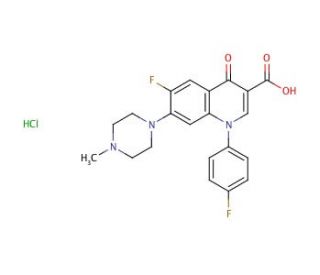

Difloxacin hydrochloride 的分子结构, CAS编号: 91296-86-5
Difloxacin hydrochloride (CAS 91296-86-5)
备用名:
6-Fluoro-1-(4-fluorophenyl)-1,4-dihydro-7-(4-methylpiperazino)-4-oxo-3-quinolinecarboxylic acid hydrochloride
应用:
Difloxacin hydrochloride是一种抗菌喹诺酮类抗生素
CAS号码:
91296-86-5
纯度:
≥98%
分子量:
435.86
分子式:
C21H19F2N3O3•HCl
仅供科研使用。不可用于诊断或治疗。
* 参考分析证明 大量特定数据 (包括水 含量).
快捷链接
订购信息
描述
技术信息
安全信息
安全技术说明书和分析证明书
二氟沙星是一种合成氟喹诺酮类抗生素,通过抑制细菌的 DNA 回旋酶发挥杀菌作用。这种抑制作用可阻止 DNA 的超螺旋,从而破坏易感细菌的 DNA 复制和转录。二氟沙星专门针对 DNA 回旋酶的 A 亚基,干扰了该酶将负超螺旋带入 DNA 的能力。这种干扰最终会导致细菌 DNA 中双链断裂的积累,从而导致细胞死亡。二氟沙星在分子水平上的作用机制是与 DNA 回旋酶形成稳定的复合物,从而阻止该酶在细菌细胞中的正常运作。这种作用机制使双氟沙星对多种革兰氏阴性菌和革兰氏阳性菌有效,因此有助于研究细菌的抗药性机制和探索抗击抗生素耐药性的潜在策略。
Difloxacin hydrochloride (CAS 91296-86-5) 参考文献
- 喹诺酮类抗生素二氟沙星可逆转培养的人类神经母细胞瘤细胞中多药耐药性相关蛋白介导的耐药性。 | Norris, MD., et al. 2001. Med Pediatr Oncol. 36: 177-80. PMID: 11464877
- 以整体聚合物为涂层的搅拌棒吸附萃取及其在蜂蜜样品中氟喹诺酮类药物分析中的应用。 | Luo, YB., et al. 2010. J Chromatogr A. 1217: 3583-9. PMID: 20394937
- 磁性一维聚苯胺的简易合成及其在磁性固相萃取蜂蜜样品中氟喹诺酮类药物中的应用。 | Gao, Q., et al. 2012. Anal Chim Acta. 720: 57-62. PMID: 22365121
- 荧光淬灭特性揭示的 DOM 介导的氟喹诺酮膜保留。 | Liang, S., et al. 2017. Sci Rep. 7: 5372. PMID: 28710360
- 通过工业规模的堆肥和厌氧消化工艺去除四环素类, 磺胺类和喹诺酮类药物。 | Liu, H., et al. 2018. Environ Sci Pollut Res Int. 25: 35835-35844. PMID: 29450774
- 盐酸二氟沙星(A-56619), A-56620 和头孢克肟(CL 284,635; FK 027)对某些生殖器病原体的体外活性。 | Bowie, WR., et al. 1986. Antimicrob Agents Chemother. 30: 590-3. PMID: 3098163
- 厌氧消化生物固体和堆肥在自然条件下短期储存期间磺胺类药物, 喹诺酮类药物和四环素类药物的消散和持久性。 | Liu, H., et al. 2019. Sci Total Environ. 684: 58-66. PMID: 31150876
- 基于 Ag-TiO2 SERS 策略检测水中的多种喹诺酮类抗生素残留。 | Wang, W., et al. 2020. Sci Total Environ. 702: 134956. PMID: 31710852
- 用于灵敏电化学-表面增强拉曼光谱(EC-SERS)检测的银纳米粒子-激光诱导石墨烯(Ag NPs - LIG)混合电极。 | Mu, Y., et al. 2023. Analyst.. PMID: 37310360
- 某些氟喹诺酮衍生物的比色法和原子吸收光谱法测定 | Salem, H. 2004. Scientia Pharmaceutica. 72(1): 51-71.
- 利用磁性纳米颗粒附着的氟碳吸附剂快速高效地去除环境水体中的有机微污染物 | Wang, W., Xu, Z., Zhang, X., Wimmer, A., Shi, E., Qin, Y.,.. & Li, L. 2018. Chemical Engineering Journal. 343: 61-68.
- Ag2S掺杂核壳纳米结构的Fe3O4@ Ag3PO4超薄薄膜:在可见光照射下空穴在快速降解污染物中的主要作用。 | Shi, E., Xu, Z., Wang, W., Xu, Y., Zhang, Y., Yang, X.,.. & Sharma, V. K. 2019. Chemical Engineering Journal,. 366: 123-132.
- 绒球状 Bi2WO6 分层纳米结构:制备及其在诺氟沙星和盐酸地氟沙星光降解中的应用 | Wu, Y., Wu, W., Chen, Q., Mao, Y., & Zhu, L. 2023. Journal of Materials Science: Materials in Electronics. 34(8): 767.
抑制剂:
Topo II.订购信息
| 产品名称 | 产品编号 | 规格 | 价格 | 数量 | 收藏夹 | |
Difloxacin hydrochloride, 5 g | sc-205648 | 5 g | $190.00 | |||
Difloxacin hydrochloride, 25 g | sc-205648A | 25 g | $846.00 |
